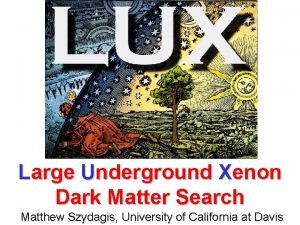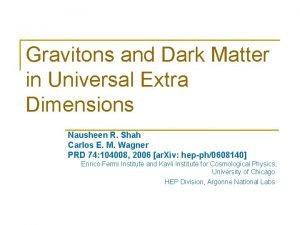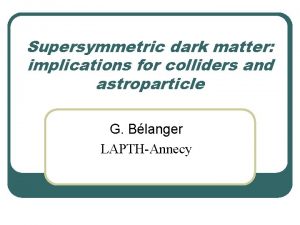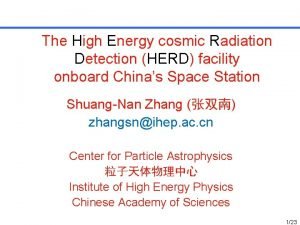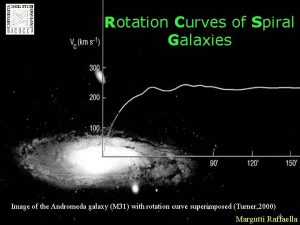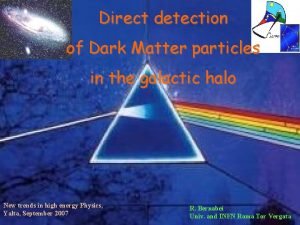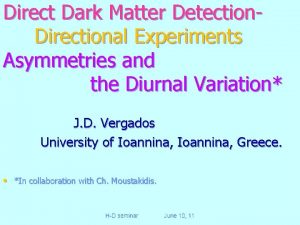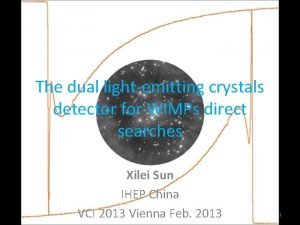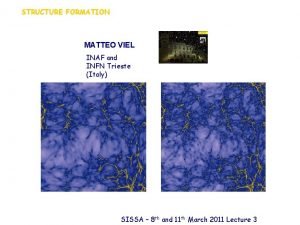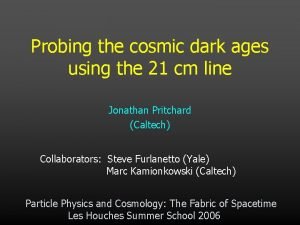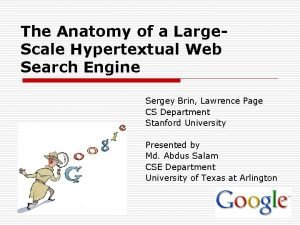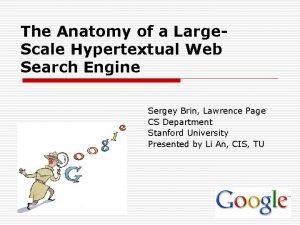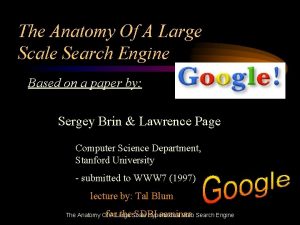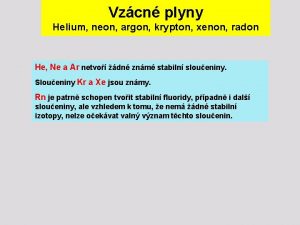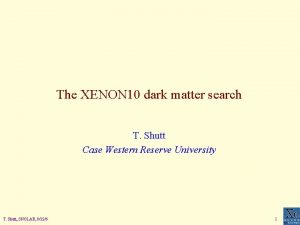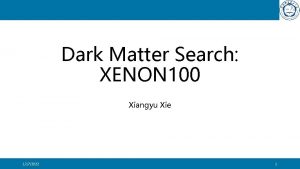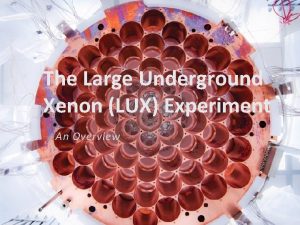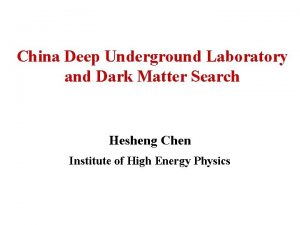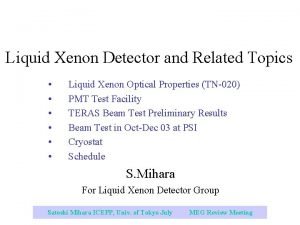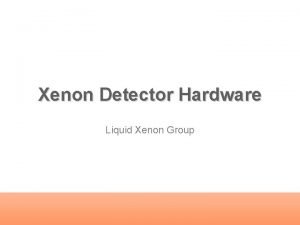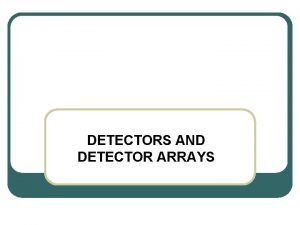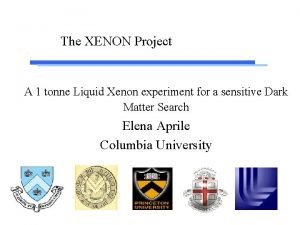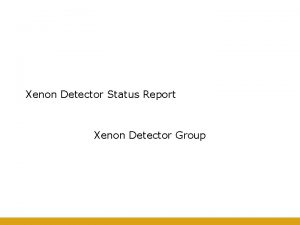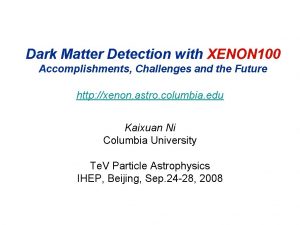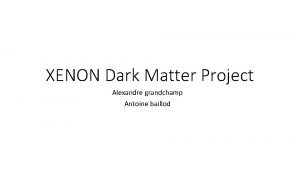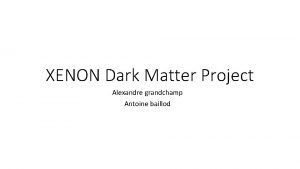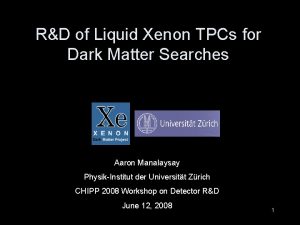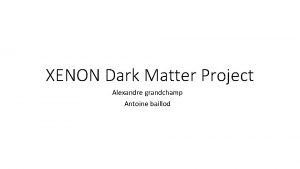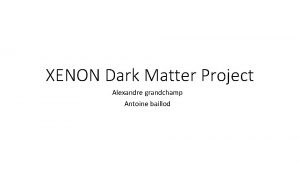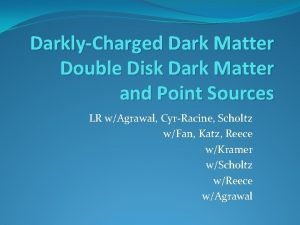Large Underground Xenon Dark Matter Search Matthew Szydagis



























- Slides: 27

Large Underground Xenon Dark Matter Search Matthew Szydagis, University of California at Davis

The LUX Collaboration Brown Richard Gaitskell Simon Fiorucci Monica Pangilinan Jeremy Chapman Carlos Hernandez Faham David Malling James Verbus PI, Professor Research Associate Postdoc Graduate Student Case Thomas. Western Shutt Dan Akerib Mike Dragowsky Carmen Carmona Ken Clark Tom Coffey Karen Gibson Adam Bradley Patrick Phelps Chang Lee Kati Pech PI, Professor Research Associate Professor Postdoc Graduate Student Harvard Masahiro Morii Michal Wlasenko John Oliver PI, Professor Postdoc Electronics Engineer Lawrence Berkeley + UC Berkeley Bob Jacobsen Jim Siegrist Bill Edwards Joseph Rasson Mia ihm Professor Engineer Graduate Student UC Santa Barbara Harry Nelson Dean White Susanne Kyre LIP Isabel Lopes. Coimbra Jose Pinto da Cunha Vladimir Solovov Luiz de Viveiros Alexander Lindote Francisco Neves Claudio Silva SD School of Mines Xinhua Bai Mark Hanardt PI, Professor Engineer PI, Professor Assistant Professor Senior Researcher Postdoc PI, Professor, Physics Group Leader Graduate Student Texas A&M James White Robert Webb Rachel Mannino Tyana Stiegler Clement Sofka PI, Professor Graduate Student UC Davis Lawrence Livermore Adam Bernstein Dennis Carr Kareem Kazkaz Peter Sorensen PI, Leader of Adv. Detectors Group Mechanical Technician Staff Physicist Postdoc University of Maryland Carter Hall Douglas Leonard PI, Professor Postdoc The most recent collaboration meeting was held in Lead, SD in March 2011. Collaboration was formed in 2007 and fully funded by DOE and NSF in 2008. Mani Tripathi Robert Svoboda Richard Lander Britt Hollbrook John Thomson Matthew Szydagis Jeremy Mock Melinda Sweany Nick Walsh Michael Woods Sergey Uvarov PI, Professor Senior Engineer Senior Machinist Postdoc Graduate Student Graduate Student University of Rochester PI, Professor Frank Wolfs Wojtek Skutski Eryk Druszkiewicz Mongkol Moongweluwan U. South Dongming. Dakota Mei Wengchang Xiang Chao Zhang Oleg Perevozchikov Senior Scientist Graduate Student PI, Professor Postdoc Yale Daniel Mc. Kinsey Peter Parker James Nikkel Sidney Cahn Alexey Lyashenko Ethan Bernard Blair Edwards Louis Kastens Nicole Larsen PI, Professor Research Scientist Lecturer/Research Scientist Postdoc Graduate Student 1

Direct detection of WIMP dark matter r ~ 300 proton masses per liter of space. If MWIMP = 100 Ge. V, then 3 WIMPs/L. Typical orbital velocity ~ 230 km/s, or 0. 1% speed of light. Coherent scalar interactions: s proportional to A 2. Rate < 1 event / kg / 100 days, or much, much lower 2

The Physics of Noble Element Scintillation • • Energy usually deposited in 2 channels • Excitation => scintillation in liquid (S 1) • Ionization => more scintillation in liquid (e-’s recombine) or in the gas (S 2) Energy lost to heat for nuclear recoils. Makes signal smaller, but helps make them different. 3

Self-shielding of LXe, a dense liquid, is extremely powerful hard for a gamma or a neutron to cross the full volume without scattering more than once low-energy gammas that can mimic a WIMP should not even make it to the fiducial volume external neutrons and gammas have to face water shield first Fiducial volume cut rejects most backgrounds anyway… 4

Electron Recoils vs. Nuclear Recoils C. E. Dahl, Ph. D. Thesis, 2009 Ionization-to-scintillation ratio allows discrimination between common radioactivity and WIMP events. Background rejection factor of 99. 5%. Well-established technology and methodology (XENON 10/100, Xed, LUX 0. 1, ZEPLIN-III, others). 5

The WIMP Hunters’ Hut in the Hills Homestake (Lead, SD) — once an Au mine Davis Cavern @ Homestake, March 2011 7 6

Davis Cavern @ Homestake, March 2011 (Former Home of the Homestake Solar Neutrino Experiment) 7

LUX Detector - Overview Aspect ratio of 1. 2 : 1 6 m diameter H 2 O Cerenkov shield around Animations: Harvard-Smithsonian Center for Astrophysics, Annenberg Media Dual-Phase Liquid Xenon Time Projection Chamber (TPC), 350 kg in total mass O(1) k. V/cm drift field in liquid, and O(10) k. V/cm field in the gas stage for S 2 production 122 Hamamatsu R 8778 PMTs are divided equally between top and bottom 8 3 -D imaging via TPC technique defines 100 kg fiducial mass, self-shielding used

LUX Detector - Overview LN bath column Feed-throughs for cables / pipes Radiation shield Titanium Vessels Anode grid PMT holding copper plates 59 cm 49 cm Dodecagonal field cage + PTFE reflector Cathode grid panels Counterweight Gaitskell - Brown University / LUX 9

LUX – Surface Facility @ Homestake 10

Test deployment of LUX in the Surface Facility Water Tank – April 2011 Putting it all together on the surface first… Recent progress: LUX cryostat successfully cooled to liquid xenon temperature – May 2011. 11

PMTs and Signals Photomultiplier Tubes (PMTs) • Hamamatsu R 8778 (2’’ diameter) • Gain of 3. 3 x 106 (DM search mode) • Average QE of 33% at room temperature _and 178 nm wavelength 12 See talk of C. H. Faham (Photon Detectors) for more information on the PMTs we use

Data Acquisition System Schematic LUX DAQ paper in preparation • Custom-built analog electronics and custom-built digital trigger • Can identify S 1 and S 2 pulses in real time, trigger on S 1, S 2, or S 1+S 2 for events • Specially shaped signals for the digitizer, digital trigger, and analog trigger • 1. 5 k. Hz acquisition rate w/o dead time => dark matter calibrations w/ zero dead time • 99. 99% zero suppression, and can trigger by position and by energy • 95% of single photoelectrons constitute >5σ upward fluctuation in baseline noise • 120 ke. Vee dynamic range with dark matter search gains 13

Pulse Only Digitization (POD) Mode and DDC-8 Trigger System • 24 pretrigger samples and 31 posttrigger samples recorded • Rolling average of baseline recorded with each pulse (16, 32, 64, or 128 samples) • 2 double-hagenauer filters (S 1 and S 2) and robust threshold logic See poster of J. Chapman for more information on the DAQ system 14

Case Western Reserve University 15

New analytic technique to detect krypton at the part-per-trillion level ar. Xiv: 1103. 2714 v 1 LN 2 GOAL: O(10) ppt 85 Kr - Leads to an event rate of O(0. 1) events in the 2 -10 ke. Vee regime after 104 Residual Gas kg-days and 99. 5% Analyzer mass - recoils rejection of e spectrometer 1. 5 ppt Kr open leak valve 16

137 Cs 208 Tl Am/Be 252 Cf source strengths chosen such that there in no pileup (200 Hz is max) 17

Simulations • S 2 (preliminary) D. Stolp S 1 M. Woods -LUXSim paper in preparation -decay chain generator paper: ar. Xiv: 1104. 2834 -scintillation physics: ar. Xiv: 1106: 1613 • Very thorough and flexible Geant 4 simulation of the geometry: LUXSim – For understanding the light collection efficiency for the PMTs – For helping know the physics reach – Component-centric approach in Geant – Includes the small background contributions from all the components: decay chain generator – 3 -D visualization with Open. GL: shoot particles Results in minutes or hours at most with 105 - 106 events, analysis fast 18

LUX Monte Carlo of the First 40 days • • • Red Points: WIMP events after only 40 days assuming a WIMP model for mass 100 Ge. V at current best 90% CL exclusion sensitivity Blue Points: Total # of single scatter electron recoil events (before any cuts) after 40 days of running LUX – strong emphasis on WIMP discovery / Plan to run LUX for 300 days XENON 100 4, 000 kg-days for comparison. Note much higher electron recoil rate ar. Xiv: 1104. 2549 v 1 D. Malling 19

Cryogenics: Thermosyphon Cooling System • • • TS successfully run in May 2011. Max cooling rate is 1 K/hr. Held target temperature (175 -185 K) for days with 50 W PID heaters. Heat exchange system more than 95% efficient. 20 See talk of A. W. Bradley for more information

LUX dark matter sensitivity CDMS 2009 XENON 100 2011 Super. CDMS 2 -ST LUX 30, 000 kg-days Status: LUX is now being tested on the surface at Homestake. Moving underground in December of 2011. 21

Evolution over Time LUX (constr: 2009 -2010, ops: 20112012) 100 kg x 300 days LZS (constr: 2012 -2013, ops: 20142015) 1, 500 kg x 500 days LZD (constr: 2015 -2017, ops: 20182020 13, 500 kg x 1, 000 days NOTE: Masses not finalized. ‘S’->Sanford Lab. ‘D’->DUSEL. • • Projections based on – Known background levels – Previously obtained electron attenuation lengths – Previous discrimination factors Careful fiducial volume selection – <1 nuclear recoil event during planned exposure (total) 22

A Brief Summary • Two signals: discrimination between nuclear, electron recoils when looking at ratio of S 2 to S 1 • Self-shielding of Xe helps you even more • Powerful and flexible LUX DAQ • Proven 85 Kr removal and measurement systems • Thorough calibration with different sources inside and out • Robust Monte Carlo simulation of geometry and physics • Proven cryogenic system • Incredible discovery potential • Undergoing testing on surface right now, with the underground deployment around the corner 23

Extra Slides

Can also detect electronegative impurities at a less than 1 ppb level Xe is constant due to cold trap ar. Xiv: 1002. 2742 ~few ppm Ar 18 ppb N 2 5 ppb O 2 0. 25 ppb CH 4 open leak valve, bypass gas purifier flow through gas purifier bypass gas purifier close leak valve to measure backgrounds

Heat Exchanger Operates >96% Efficient Demonstrated - 18 W required to circulate 0. 4 tons of Xe a day Evaporate Liquid > Gas / Purification -> Re-condense Liquid LUX 0. 1
 Matthew szydagis
Matthew szydagis Dark matter and dark energy ppt
Dark matter and dark energy ppt In the dark dark town
In the dark dark town Matter gravitons other dimensions
Matter gravitons other dimensions Boosted dark matter
Boosted dark matter Dark matter
Dark matter Dark matter pwo
Dark matter pwo Dark matter physics
Dark matter physics Where to stream dark matter
Where to stream dark matter What could dark matter be
What could dark matter be Dark matter
Dark matter Matteo viel
Matteo viel Dark matter
Dark matter Les houches dark matter
Les houches dark matter Classification of matter section 1 composition of matter
Classification of matter section 1 composition of matter Gray and white matter
Gray and white matter Composition of matter section 1
Composition of matter section 1 Chapter 2 section 1 classifying matter answer key
Chapter 2 section 1 classifying matter answer key Dural septa
Dural septa Composition of matter section 1
Composition of matter section 1 Gray matter and white matter
Gray matter and white matter Pallium telencephalon
Pallium telencephalon Ecological succession
Ecological succession The anatomy of a large scale hypertextual web search engine
The anatomy of a large scale hypertextual web search engine The anatomy of a large scale hypertextual web search engine
The anatomy of a large scale hypertextual web search engine The anatomy of a large scale hypertextual web search engine
The anatomy of a large scale hypertextual web search engine The anatomy of a large-scale hypertextual web search engine
The anatomy of a large-scale hypertextual web search engine Neon argon krypton xenon radon
Neon argon krypton xenon radon
